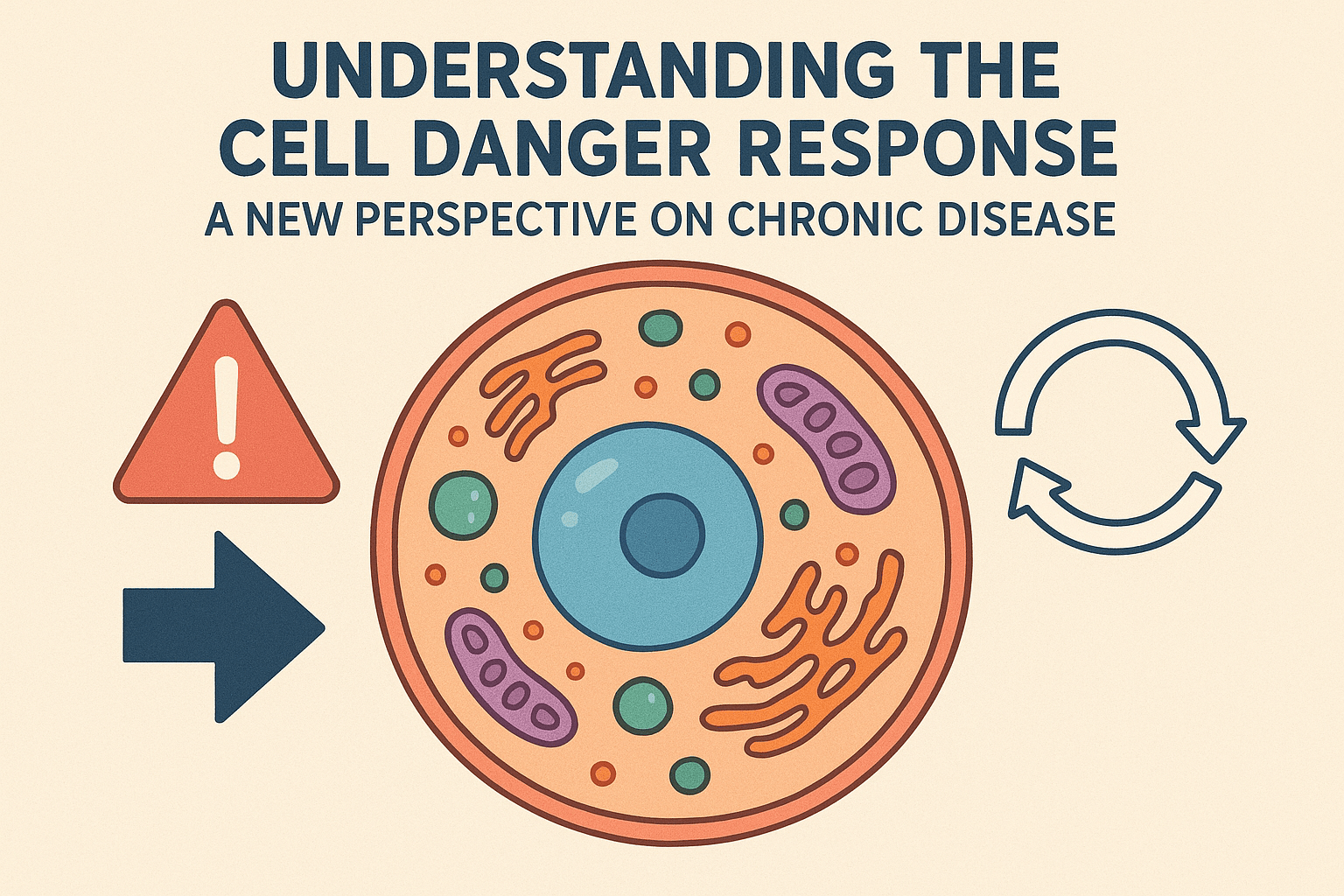The human body is an extraordinary product of evolution, equipped with intricate defense systems designed to ensure survival against constant internal and external threats. One of the most fundamental of these is the Cell Danger Response (CDR) — a universal, evolutionarily conserved metabolic program first identified by Dr. Robert Naviaux.
The CDR represents a cell’s structured and prioritized response to chemical, physical, or biological stressors that overwhelm its normal homeostasis — from viral infections and toxins to chronic psychological stress. While essential for short-term survival, persistent activation of this defense system can lead to long-term dysfunction. Increasing evidence suggests that an unresolved or chronic CDR lies at the root of many complex conditions, including chronic fatigue syndrome (ME/CFS), autism spectrum disorder (ASD), post-traumatic stress disorder (PTSD), and several autoimmune diseases.
Rather than viewing chronic illness as a failure of the body, the CDR reframes it as a state of incomplete healing. When danger signals never fully resolve, cells remain “stuck” in a defensive state, diverting energy away from essential activities like tissue repair, detoxification, and immune regulation. This ongoing state of metabolic stress creates a self-perpetuating loop of inflammation, fatigue, and organ dysfunction — offering a powerful new lens for diagnosing and treating chronic, multi-system conditions. Understanding how to guide cells through the phases of the CDR is key to restoring health and completing the healing cycle.
The Mitochondria: Sentinel and Switch of Cellular Defense
At the core of the CDR are the mitochondria, traditionally known as the cell’s powerhouses. Modern research reveals they play a far greater role — serving as cellular sentinels that constantly monitor the environment for danger, acting as the “early warning system” for stress.
When mitochondria detect a threat, they initiate a rapid metabolic shift — the hallmark of the CDR. Under normal conditions, cells generate energy through oxidative phosphorylation (OXPHOS), an efficient oxygen-dependent process that produces abundant ATP. Upon sensing danger, cells deliberately suppress OXPHOS and switch to glycolysis, a more primitive but faster energy pathway.
This reprogramming has two purposes:
- Conservation and containment — Oxygen and molecular building blocks are preserved, depriving pathogens of resources.
- Defense activation — Mitochondria redirect energy toward producing reactive oxygen species (ROS) and reinforcing cell membranes to contain damage.
This metabolic “gear shift” defines the acute CDR phase. If cells fail to revert back to normal OXPHOS once the threat is gone, the body remains locked in a chronic, low-energy state that drives persistent illness.
The Three Phases of the Healing Cycle
Dr. Naviaux outlined the CDR as a three-stage healing cycle, each with a critical metabolic checkpoint (CP). Failure to progress through these checkpoints leads to chronic disease.
Stage 1: CDR1 — Defense and Containment
- Purpose: Detect danger, contain damage, and activate innate immunity.
- Metabolism: Glycolysis dominates while OXPHOS is suppressed.
- Mitochondria: Shift from the resting M2 (efficient) to the M1 (defensive) phenotype.
- Signaling: High extracellular ATP (eATP) acts as a danger signal, triggering pain, inflammation, and fatigue.
- Checkpoint (CP1): Resolution of the initial threat (infection or toxin removal). Failure results in chronic inflammation.
Stage 2: CDR2 — Repair and Regeneration
- Purpose: Rebuild damaged tissue and replace lost cells.
- Metabolism: Aerobic glycolysis supports synthesis of new lipids, amino acids, and nucleotides.
- Mitochondria: Undifferentiated M0 mitochondria assist with tissue repair and growth.
- Checkpoint (CP2): Requires successful remodeling. Failure can cause fibrosis or abnormal tissue growth.
Stage 3: CDR3 — Restoration and Connection
- Purpose: Restore specialized cell functions, reconnect communication, and return to metabolic balance.
- Metabolism: OXPHOS resumes, eATP levels normalize.
- Mitochondria: Return to the M2 (homeostatic) phenotype.
- Checkpoint (CP3): Confirmation that the body is safe. Failure leads to chronic fatigue and low-energy states.
Molecular Drivers of Defense and Dysfunction
Several key molecular mechanisms drive the CDR and determine whether healing progresses or stalls:
- Extracellular ATP (eATP): Normally an energy molecule, ATP becomes a powerful danger signal when released outside the cell. Chronic eATP signaling sustains inflammation and suppresses mitochondrial recovery.
- Reactive Oxygen Species (ROS): Essential in small amounts for defense, but prolonged elevation damages lipids and DNA, perpetuating oxidative stress.
- Membrane Stiffening: During the CDR, membranes become more rigid to block threats but lose flexibility needed for normal signaling. Oxidized lipids reinforce this dysfunction, trapping the cell in survival mode.
- Vitamin D Disruption: The CDR alters Vitamin D metabolism, suppressing activation and promoting inflammation — explaining the link between Vitamin D deficiency and chronic immune dysfunction.
Why the CDR Gets Stuck
In a healthy system, the CDR resolves once the threat passes. Chronic disease occurs when danger signals persist due to a mix of internal and environmental stressors:
- Continuous exposure to toxins (mold, heavy metals, pesticides).
- Chronic infections that evade immune clearance.
- Ongoing oxidative stress and membrane damage.
- Prolonged psychological stress or trauma, which can activate the CDR through brain–body pathways.
When stuck, the body prioritizes survival over recovery. The result is widespread fatigue, neuroinflammation, disrupted gut health, and reduced detoxification — symptoms common in fibromyalgia, autoimmune diseases, and neurological disorders.
Turning Off the Danger Signal: The Promise of Low-Dose Naltrexone (LDN)
Treating chronic CDR states requires more than symptom management — it involves breaking the feedback loops that keep cells in defense mode. One emerging therapy is Low-Dose Naltrexone (LDN).
Originally used in high doses to treat addiction, LDN (1.5–4.5 mg) works differently at lower concentrations. It briefly blocks opioid receptors, stimulating the release of natural opioids such as Opioid Growth Factor (OGF), which regulate immune function and reduce inflammation.
More importantly, LDN inhibits Toll-Like Receptor 4 (TLR4) — a key immune sensor responsible for maintaining inflammatory signaling. By calming overactive microglia and reducing cytokine release (e.g., TNF-α, IL-6), LDN helps the body shift from the inflammatory M1 state toward the restorative M2 state, promoting true healing.
Through these effects, LDN helps quiet the cellular “danger alarms,” enabling cells to move through the healing checkpoints and complete the recovery process.
A New Era of Metabolic Medicine
The Cell Danger Response provides a groundbreaking framework for understanding chronic illness — not as a collection of unrelated diseases, but as variations of the same biological defense system stuck in overdrive.
Future treatments will focus on two main goals:
- Removing the root causes — eliminating toxins, treating hidden infections, and managing psychological stress.
- Restoring cellular balance — repairing membranes, supporting mitochondria, and modulating inflammation with tools like LDN.
By identifying which stage of the CDR a patient is trapped in, clinicians can apply targeted therapies to guide cells back through the healing cycle.
Ultimately, the CDR marks a shift from disease-centered to health-centered medicine — a model that recognizes healing as an active, programmable process. Understanding and resolving the CDR may be the key to reversing the growing epidemic of chronic, multi-system diseases.





